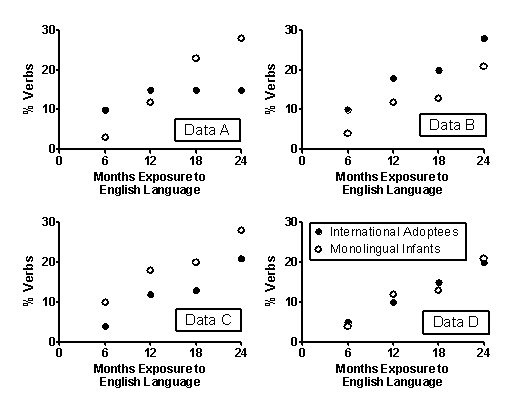Scenario I
Scenario I is based on and presents results consistent with the following studies:
Snedeker, J., Geren, J., & Shafto, C. L. (2012) . Disentangling the effects of cognitive development and linguistic expertise: A longitudinal study of the acquisition of English in internationally-adopted children. Cognitive Psychology, 65(1) , 39-76. doi:10.1016/j.cogpsych.2012.01.004
Snedeker, J., Geren, J., & Shafto, C. L. (2007) . Starting over: International adoption as a natural experiment in language development. Psychological Science, 18(1) , 79-87. doi:10.1111/j.1467-9280.2007.01852.x
Language development occurs in orderly stages, beginning with one-word utterances and progressing to two-word utterances, simple sentences containing function morphemes, and the emergence of grammatical rules. Psycholinguists have attempted to determine if language development is a consequence of cognitive development or if it reflects linguistic processes that occur independently of general cognitive development. Studies on the acquisition of a second language in internationally adopted children have provided insight into this research question. In a series of studies, Snedeker et al. (2007, 2012) studied the acquisition of the English language in adopted preschoolers from China. These children had no exposure to the English language before being adopted by families in the United States.
Figure 9.1 
-(Scenario I) Which is the BEST reason why the research question posed in Scenario I could not be answered by studying infants' acquisition of the English language and comparing it to infants' acquisition of the Spanish language in American-born bilingual homes?
Definitions:
Accounting Profit
Accounting profit is the net income for a company calculated by subtracting total expenses from total revenues, according to generally accepted accounting principles.
Explicit Costs
Payments made directly to individuals or entities for wages, rent, and materials as part of business operations.
Items
Individual objects, products, or units that are part of a list, collection, or inventory available for sale or distribution.
Accounting Cost
The recorded expenses associated with the operation of a business, including both fixed and variable costs.
Q6: Asian and African cultures are more likely
Q7: Human language results from the complex interplay
Q15: Genetic and environmental factors are independent influences
Q37: Behaviorist explanations of language development emphasize how
Q41: Studies suggest that being raised in a
Q60: The gray matter in the _ lobe
Q65: Capgras syndrome is caused by damage to
Q68: According to the Schachter-Singer two-factor theory of
Q88: On the day 2-year-old Isabel helped her
Q105: On average, patients with prefrontal cortex damage